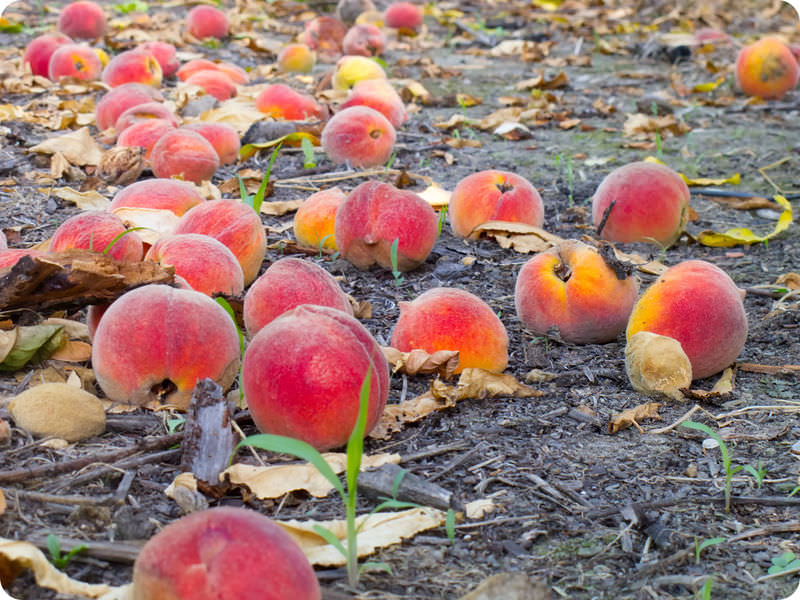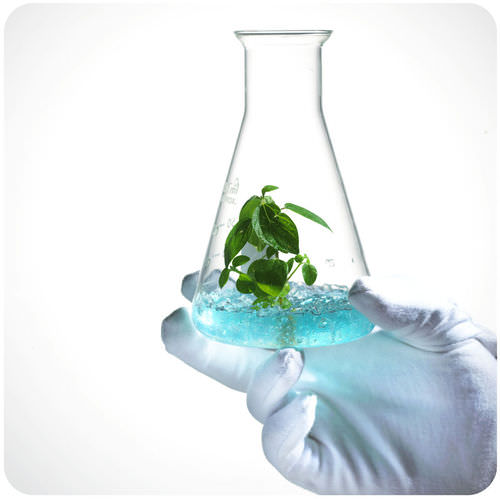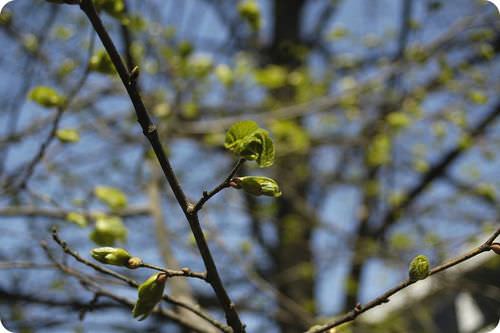7.12: Plant Hormones
- Page ID
- 13780

How do fruits know when to fall?
Fruits, such as these peaches, do not leave their trees until it's the right time. The seeds are mature, and the fruit is ripe. But what tells the fruits it's time to drop? The signal that is sent through the tree is a type of hormone. Hormones also send signals through your body.
Plant Hormones
Plants may not move, but that does not mean they don't respond to their environment. Plants can sense gravity, light, touch, and seasonal changes. For example, you might have noticed how a house plant bends toward a bright window. Plants can sense and then grow toward the source of light. Scientists say that plants are able to respond to "stimuli," or something—usually in the environment—that results in a response. For instance, light is the stimulus, and the plant moving toward the light is the "response."
Hormones are special chemical messengers molecules that help organisms, including plants, respond to stimuli in their environment. In order for plants to respond to the environment, their cells must be able to communicate with other cells. Hormones send messages between the cells. Animals, like humans, also have hormones, such as testosterone or estrogen, to carry messages from cell to cell. In both plants and animals, hormones travel from cell to cell in response to a stimulus; they also activate a specific response.
Types of Plant Hormones
Five different types of plant hormones are involved in the main responses of plants, and they each have different functions (Table below).
| Hormone | Function |
|---|---|
| Ethylene | Fruit ripening and abscission |
| Gibberellins | Break the dormancy of seeds and buds; promote growth |
| Cytokinins | Promote cell division; prevent senescence |
| Abscisic Acid | Close the stomata; maintain dormancy |
| Auxins | Involved in tropisms and apical dominance |
Ethylene
The hormone ethylene has two functions. It (1) helps ripen fruit and (2) is involved in the process of abscission, the dropping of leaves, fruits, and flowers. When a flower is done blooming or a fruit is ripe and ready to be eaten, ethylene causes the petals or fruit to fall from a plant (Figure below and Figure below).
Ethylene is an unusual plant hormone because it is a gas. That means it can move through the air, and a ripening apple can cause another apple to ripen, or even over-ripen. That’s why one rotten apple spoils the whole barrel! Some farmers spray their green peppers with ethylene gas to cause them to ripen faster and become red peppers.
You can try to see how ethylene works by putting a ripe apple or banana with another unripe fruit in a closed container or paper bag. What do you think will happen to the unripe fruit?


Gibberellins
Gibberellins are hormones that cause the plant to grow. When gibberellins are applied to plants by scientists, the stems grow longer. Some gardeners or horticulture scientists add gibberellins to increase the growth of plants. Dwarf plants (small plants), on the other hand, have low levels of gibberellins (Figure below). Another function of gibberellins is to stop dormancy (resting time) of seeds and buds. Gibberellins signal that it’s time for a seed to germinate (sprout) or for a bud to open.

Cytokinins
Cytokinins are hormones that cause plant cells to divide. Cytokinins were discovered from attempts to grow plant tissue in artificial environments (Figure below). Cytokinins prevent the process of aging (senescence). So florists sometimes apply cytokinins to cut flowers, so they do not get old and die.

Abscisic Acid
Abscisic acid is misnamed because it was once believed to play a role in abscission (the dropping of leaves, fruits, and flowers), but we now know abscission is caused by ethylene. The actual role of abscisic acid is to close the stomata, the tiny openings in leaves that allow substances to enter and leave, and to maintain dormancy. When a plant is stressed due to lack of water, abscisic acid tells the stomata to close. This prevents water loss through the stomata.
When the environment is not good for a seed to germinate, abscisic acid signals for the dormancy period of the seed to continue. Abscisic acid also tells the buds of plants to stay in the dormancy stage. When conditions improve, the levels of abscisic acid drop and the levels of gibberellins increase, signaling that is time to break dormancy (Figure below).

Auxins
Auxins are hormones that play a role in plant growth. Auxins produced at the tip of the plant are involved in apical dominance, when the main central stem grows more strongly than other stems and branches. When the tip of the plant is removed, the auxins are no longer present, and the side branches begin to grow. This is why pruning a plant by cutting off the main branches helps produce a fuller plant with more branches. You actually need to cut branches off of a plant for it to grow more branches! Auxins are also involved in tropisms, responses to stimuli in the environment
Summary
- Plant hormones are chemical signals that control different processes in plants.
- Plant hormones include ethylene, gibberellins, cytokinins, absciscic acid, and auxins.
Explore More
Use the resource below to answer the questions that follow.
- Plant Hormones at http://www.youtube.com/watch?v=ZbRiKlIYa-k (5:39)
- What hormones stimulate plant growth?
- What hormones inhibit plant growth?
- Why is it important for a plant to be able to both stimulate and inhibit growth? Explain your answer.
- Do you think hormones are more important to plants or mammals? Explain your thinking.
Review
- What are three stimuli that plants respond to?
- List the roles of gibberellins.
- What hormone is involved in fruit ripening?
- What happens to an unripe fruit when placed in a paper bag with a ripe fruit?
- What is apical dominance?

